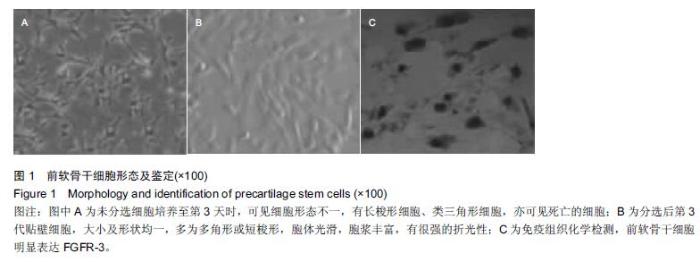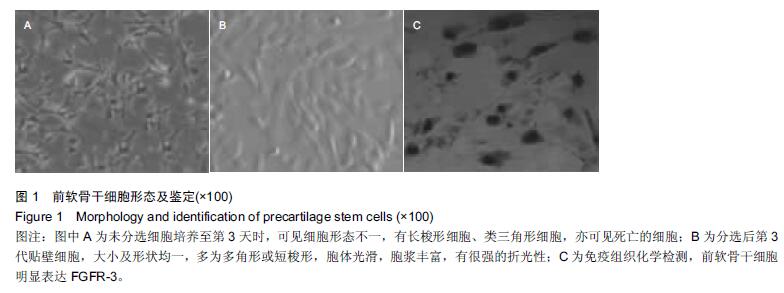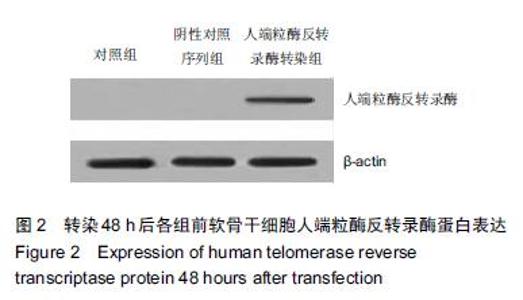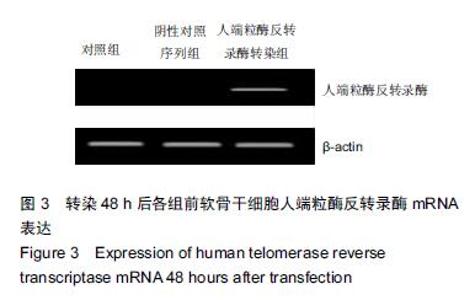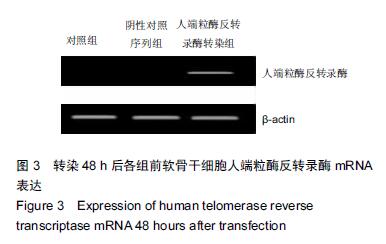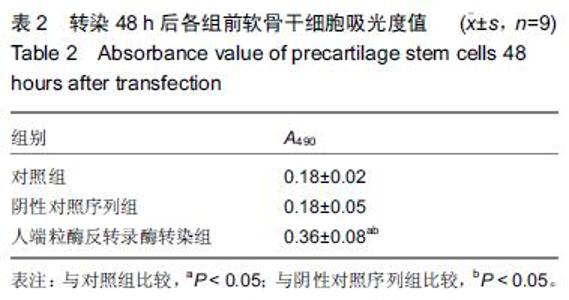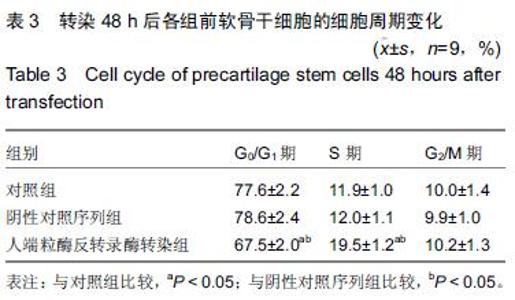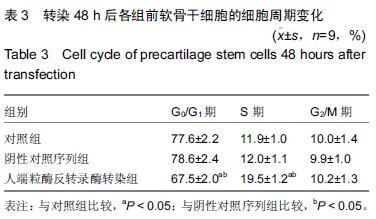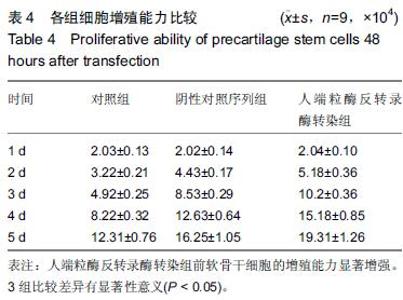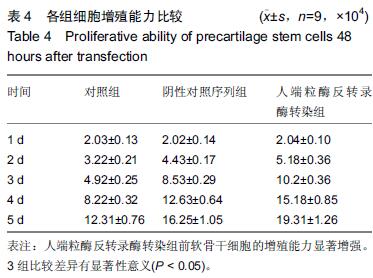Chinese Journal of Tissue Engineering Research ›› 2016, Vol. 20 ›› Issue (14): 2110-2116.doi: 10.3969/j.issn.2095-4344.2016.14.020
Previous Articles Next Articles
Electrotransfection by human telomerase reverse transcriptase gene: optimization in precartilagious stem cell culture
Peng Yi, Qu Jia-fu, Cao Li-hai, Zhao Guo-zhi, Du Xiao-jian
- Department of Foot and Ankle Surgery, the Second Hospital of Tangshan, Tangshan 063000, Hebei Province, China
-
Received:2016-02-26Online:2016-04-01Published:2016-04-01 -
About author:Peng Yi, Master, Associate chief physician, Department of Foot and Ankle Surgery, the Second Hospital of Tangshan, Tangshan 063000, Hebei Province, China -
Supported by:the Scientific Research Plan Project of Xingtai City, No. 2015ZC076
Cite this article
Peng Yi, Qu Jia-fu, Cao Li-hai, Zhao Guo-zhi, Du Xiao-jian. Electrotransfection by human telomerase reverse transcriptase gene: optimization in precartilagious stem cell culture[J]. Chinese Journal of Tissue Engineering Research, 2016, 20(14): 2110-2116.
share this article
| [1] Komárek J, Vališ P, Repko M, et al. Treatment of deep cartilage defects of the knee with autologous chondrocyte transplantation: long-term results.Acta Chir Orthop Traumatol Cech. 2010;77(4):291-295. [2] 顾晓峰,王琼,夏仁云,等. 转化生长因子β1诱导永生化人前软骨干细胞向髓核样细胞分化的实验研究[J].中华骨科杂志,2012,32(3):271-276. [3] 丁然,王庆,蔡贤华.转化生长因子-β不同亚型对前软骨干细胞增殖分化的影响[J].华中科技大学:医学版,2013, 42(6):659-664. [4] 黄国平.转人端粒酶基因骨髓间充质干细胞的构建及其细胞特征分析[D].杭州:浙江大学,2007. [5] Varras M, Polonifi K, Mantzourani M, et al. Expression of antiapoptosis gene survivin in luteinized ovarian granulosa cells of women undergoing IVF or ICSI and embryo transfer: clinical correlations. Reprod Biol Endocrinol. 2012;10:74. [6] Lee MS, Liu CH, Lee TH, et al. Association of creatin kinase B and peroxiredoxin 2 expression with age and embryo quality in cumulus cells. J Assist Reprod Genet. 2010;27(11):629-639. [7] Ouandaogo ZG, Haouzi D, Assou S, et al. Human cumulus cells molecular signature in relation to oocyte nuclear maturity stage. PLoS One. 2011;6(11):e27179. [8] 叶田.TERT在人卵巢颗粒细胞中的表达及与体外受精-胚胎移植结局关系的研究[J].郑州:郑州大学,2013. [9] Ding D, Zhou J, Wang M, et al. Implications of telomere-independent activities of telomerase reverse transcriptase in human cancer. FEBS J. 2013; 280(14): 3205-3211. [10] Zhou JZ,Xi P,Zhou Q, et al. The putative tumor suppressor C53 interacts with the human telomerase reverse transcriptase hTERT and regulates telomerase activity.Chin Sci Bull. 2014;59(19):2324-2330. [11] Chen FH, Rousche KT, Tuan RS. Technology Insight: adult stem cells in cartilage regeneration and tissue engineering. Nat Clin Pract Rheumatol. 2006;2(7): 373-382. [12] Masotti A, Mossa G, Cametti C, et al. Comparison of different commercially available cationic liposome-DNA lipoplexes: Parameters influencing toxicity and transfection efficiency. Colloids Surf B Biointerfaces. 2009;68(2):136-144. [13] Horton WA, Hall JG, Hecht JT. Achondroplasia.Lancet. 2007;370(9582):162-172. [14] 李昆朋,许涛,杜宇,等.波长620 nm红光促进前软骨干细胞向软骨细胞分化的实验研究[J].中华物理医学与康复杂志, 2012,34(3):172-176. [15] 孙晓宇.前软骨干细胞对于周围神经再生的功能与作用[J].内蒙古民族大学学报2010,25(1):105-107. [16] 杨宝林,刘德明. 异种雪旺细胞移植在中枢神经系统损伤修复中的作用[J].江西医学院学报,2005,45(5):185-187. [17] Schagemann JC, Kurz H, Casper ME, et al. The effect of scaffold composition on the early structural characteristics of chondrocytes and expression of adhesion molecules. Biomaterials. 2010;31(10): 2798-1805. [18] 滕勇,胡蕴玉,王臻,等.成人骨髓基质干细胞体外定向诱导分化为软骨细胞的实验研究[J].中华实验外科杂志,2005, 22(2):144-146. [19] Khan IM, Redman SN, Williams R, et al. The development of synovial joints. Curr Top Dev Biol. 2007;79:1-36. [20] Abdallah BM, Haack-Sørensen M, Burns JS, et al. Maintenance of differentiation potential of human bone marrow mesenchymal stem cells immortalized by human telomerase reverse transcriptase gene despite [corrected] extensive proliferation. Biochem Biophys Res Commun. 2005;326(3):527-538. [21] 邢莹,秦洁,曹孟德,等. 细胞因子诱导人脐血间充质干细胞分化过程中细胞巢蛋白、神经丝亚单位和端粒酶逆转录酶mRNA的表达[J].郑州大学学报:医学版,2005,40(2): 250-253. [22] Autexier C, Lue NF. The structure and function of telomerase reverse transcriptase. Annu Rev Biochem. 2006;75:493-517. [23] 唐峰,顾栋桦,王虹,等.端粒酶hTERT mRNA表达在乳腺癌进展中的意义及其与p53的相关性[J].中华肿瘤杂志, 2006,28(3):192-195. [24] 张洁,廖亚平,吴灵芝,等.hTERT基因转染对人胚胎皮层神经元生长的影响[J].解剖学研究,2008,30(4):251-256. [25] Xu L, Li S, Stohr BA. The role of telomere biology in cancer. Annu Rev Pathol. 2013;8:49-78. [26] 吴灵芝,李水彬,程刚卫,等. hTERT基因转染对人神经元活力的影响[J].赣南医学院学报,2014,34(2):170-173. [27] Harley CB.Telomerase and cancer therapeutics.Nat Rev Cancer. 2008;8(3):167-179. [28] 靳斌,王伟,刘泽阳,等.外源hTERT基因转染对老年大鼠供肝缺血再灌注损伤的防护作用[J].山东大学学报:医学版,2013,51(8):13-16. [29] Park YJ, Kim EK, Moon S, et al. Human telomerase reverse transcriptase is a promising target for cancer inhibition in squamous cell carcinomas.Anticancer Res. 2014;34(11):6389-6395. [30] 刘云燕,裘秀春,张殿忠,等. hTERT反义寡核苷酸对脊索瘤细胞周期及增殖的影响[J].现代肿瘤医学,2011, 19(10):1922-1924. [31] 张晓辉,张建宁,康春生,等.hTERT正、反义表达载体转染大鼠骨髓间充质干细胞的实验 研究[J].中华神经医学杂志,2006,5(3):217-221. [32] 张志宏,曾永秋,税青林,等. hTERT-siRNA表达载体的构建及对MCF-7细胞生长、端粒酶活性的抑制作用[J].解放军医学杂志,2007,32(6):561-564. [33] 李宏良,曾荣香,陈鹏,等. 清毒片和hTERT反义核酸对HL-60细胞增殖及凋亡的协同作用[J].辽宁中医杂志, 2010,37(3):395-398. [34] Abdallah BM, Haack-Sørensen M, Burns JS, et al. Maintenance of differentiation potential of human bone marrow mesenchymal stem cells immortalized by human telomerase reverse transcriptase gene despite [corrected] extensive proliferation. Biochem Biophys Res Commun. 2005;326(3):527-538. [35] 王开利,迟淑萍,孙杰,等.外源hTERT基因对人肝细胞增殖及CYP45019A1表达的影响[J].军医进修学院学报, 2011,32(11):1137-1138.
|
| [1] | Zhang Tongtong, Wang Zhonghua, Wen Jie, Song Yuxin, Liu Lin. Application of three-dimensional printing model in surgical resection and reconstruction of cervical tumor [J]. Chinese Journal of Tissue Engineering Research, 2021, 25(9): 1335-1339. |
| [2] | Zeng Yanhua, Hao Yanlei. In vitro culture and purification of Schwann cells: a systematic review [J]. Chinese Journal of Tissue Engineering Research, 2021, 25(7): 1135-1141. |
| [3] | Ma Zetao, Zeng Hui, Wang Deli, Weng Jian, Feng Song. MicroRNA-138-5p regulates chondrocyte proliferation and autophagy [J]. Chinese Journal of Tissue Engineering Research, 2021, 25(5): 674-678. |
| [4] | Xie Chongxin, Zhang Lei. Comparison of knee degeneration after anterior cruciate ligament reconstruction with or without remnant preservation [J]. Chinese Journal of Tissue Engineering Research, 2021, 25(5): 735-740. |
| [5] | Xu Dongzi, Zhang Ting, Ouyang Zhaolian. The global competitive situation of cardiac tissue engineering based on patent analysis [J]. Chinese Journal of Tissue Engineering Research, 2021, 25(5): 807-812. |
| [6] | Wu Zijian, Hu Zhaoduan, Xie Youqiong, Wang Feng, Li Jia, Li Bocun, Cai Guowei, Peng Rui. Three-dimensional printing technology and bone tissue engineering research: literature metrology and visual analysis of research hotspots [J]. Chinese Journal of Tissue Engineering Research, 2021, 25(4): 564-569. |
| [7] | Chang Wenliao, Zhao Jie, Sun Xiaoliang, Wang Kun, Wu Guofeng, Zhou Jian, Li Shuxiang, Sun Han. Material selection, theoretical design and biomimetic function of artificial periosteum [J]. Chinese Journal of Tissue Engineering Research, 2021, 25(4): 600-606. |
| [8] | Liu Fei, Cui Yutao, Liu He. Advantages and problems of local antibiotic delivery system in the treatment of osteomyelitis [J]. Chinese Journal of Tissue Engineering Research, 2021, 25(4): 614-620. |
| [9] | Li Xiaozhuang, Duan Hao, Wang Weizhou, Tang Zhihong, Wang Yanghao, He Fei. Application of bone tissue engineering materials in the treatment of bone defect diseases in vivo [J]. Chinese Journal of Tissue Engineering Research, 2021, 25(4): 626-631. |
| [10] | Zhang Zhenkun, Li Zhe, Li Ya, Wang Yingying, Wang Yaping, Zhou Xinkui, Ma Shanshan, Guan Fangxia. Application of alginate based hydrogels/dressings in wound healing: sustained, dynamic and sequential release [J]. Chinese Journal of Tissue Engineering Research, 2021, 25(4): 638-643. |
| [11] | Chen Jiana, Qiu Yanling, Nie Minhai, Liu Xuqian. Tissue engineering scaffolds in repairing oral and maxillofacial soft tissue defects [J]. Chinese Journal of Tissue Engineering Research, 2021, 25(4): 644-650. |
| [12] | Xing Hao, Zhang Yonghong, Wang Dong. Advantages and disadvantages of repairing large-segment bone defect [J]. Chinese Journal of Tissue Engineering Research, 2021, 25(3): 426-430. |
| [13] | Chen Siqi, Xian Debin, Xu Rongsheng, Qin Zhongjie, Zhang Lei, Xia Delin. Effects of bone marrow mesenchymal stem cells and human umbilical vein endothelial cells combined with hydroxyapatite-tricalcium phosphate scaffolds on early angiogenesis in skull defect repair in rats [J]. Chinese Journal of Tissue Engineering Research, 2021, 25(22): 3458-3465. |
| [14] | Wang Hao, Chen Mingxue, Li Junkang, Luo Xujiang, Peng Liqing, Li Huo, Huang Bo, Tian Guangzhao, Liu Shuyun, Sui Xiang, Huang Jingxiang, Guo Quanyi, Lu Xiaobo. Decellularized porcine skin matrix for tissue-engineered meniscus scaffold [J]. Chinese Journal of Tissue Engineering Research, 2021, 25(22): 3473-3478. |
| [15] | Mo Jianling, He Shaoru, Feng Bowen, Jian Minqiao, Zhang Xiaohui, Liu Caisheng, Liang Yijing, Liu Yumei, Chen Liang, Zhou Haiyu, Liu Yanhui. Forming prevascularized cell sheets and the expression of angiogenesis-related factors [J]. Chinese Journal of Tissue Engineering Research, 2021, 25(22): 3479-3486. |
| Viewed | ||||||
|
Full text |
|
|||||
|
Abstract |
|
|||||
